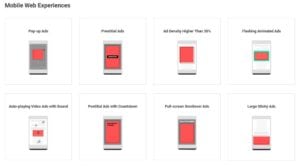
The Coalition for Better Ads is rolling out their Better Ads Experience Program to kick off the new year, while Google, which is a member of the Coalition, is launching a broader initiative through its Chrome browser. Both efforts signify a strong push (sometimes complementary, sometimes not) to clean up the internet. While both approaches aim to create a better online experience for readers, and to promote better advertising practices, we expect there to be some confusion during the initial rollouts, so we’re going to break it down for you.
What Is the Better Ads Experience Program?
The Coalition was established to create research-supported standards that define what constitutes a “bad” ad, and companies that participate in the Better Ads Experience Program have agreed that those ads falling below a certain threshold for quality should be removed from their websites. Under this program, the Coalition recognizes that there are certain “implementing entities” such as browsers that might use the standards within their own initiatives to filter out ads and clean up the digital ecosystem. Google, a member of the Coalition, will be considered an implementing entity and will include a component within their Chrome browser will automatically block the offending ads from participating publishers’ sites.
However, the internet search giant is taking things a step further. While the Coalition’s program is voluntary and requires that only participating websites meet its standards, Google has announced that they plan to apply the Better Ad Standards to all websites accessed via Chrome, regardless of their participation in the Better Ads Experience Program.
What Role Will Google Play?
If you decide to participate in the Better Ads Experience Program with the Coalition, you will be held to the Better Ad Standards, but will be given time to make corrections and have the ability to appeal the blocking of ads on your site. This means that, as a partner of the Coalition, you have 30 days to fix or remove from your site any ads that don’t meet the standards set, and you also have the option of engaging a third-party conflict resolution entity to dispute any decision on non-compliance. All of this will be run by the Coalition, which includes publishers, advertisers, ad agencies, ad tech companies, and internet companies such as Google, Microsoft and Facebook, and, as noted, will be completely voluntary.
Non-participants won’t be affected by the Coalition’s standards and practices — except when it comes to Google’s initiative, of course. While Coalition partners will have their sites assessed and disputes reconciled by the Coalition, non-participants will be subject to Google’s judgment. If you decide not to participate in the Coalition’s program but your website is accessed via Google’s Chrome browser, you will be subject to the Better Ad Standards. To Google’s credit it will give publishers the same 30 days to fix any problematic ads, but it is uncertain if publishers will be able to dispute any erroneously blocked ads beyond the 30 days. .
It is important to note here that the Coalition for Better Ads is not endorsing Google’s initiative, as it could lead to acceptable ads being blocked. Currently, technological barriers prevent Google (or any other implementing entity) from filtering out only ads that don’t meet standards. In practice, all ads would need to be blocked. The Coalition hopes that advances in technology will make “filtering” a reality.
How Will This All Work?
Whether you participate in the Better Ads Experience Program or are only subject to the standards when your site is accessed via Chrome, there are a few things you’ll need to know about what to expect.
First, there are the types of ads that do not meet the Better Ad Standards. For websites viewed on laptops or tablets, the following ads will be blocked by participating browsers: pop-up ads, auto-play video ads with sound, prestitial countdown ads that appear before a page has loaded, and large sticky ads that take up more than 30 percent of the screen.

On mobile devices, the ads being blocked are: pop-up ads, any prestitial ads that appear before content has loaded, any ads that take up more than 30 percent of the screen real estate, flashing animated ads, auto-play video ads with sound, postitial ads with countdown that appear after a user clicks a link but before the new page loads, full-screen rollover ads that float on top of a page’s content and take up more than 30 percent of the page, and large sticky ads that take up more than 30 percent of the screen for the duration of viewing. (For more detail on the ads that will lead to a low score with the Coalition, you can visit their website.)

To ease publishers into the program, it has been reported that the Coalition is looking to phase in compliance with the voluntary standards in increments. We believe Google has agreed to this phase-in as an implementing entity. Sites will either pass or fail based on the pages assessed and whether those pages meet the standards set by the Coalition. Details are still being hammered out, but the proposed rollout would give publishers two months during which they could have 7.5 percent of assessed pages below the threshold for ad quality before action is taken. That means that if an implementing entity — like Google — assesses 100 pages of a particular news site, and seven of those pages have bad ads, they’ll be allowed to continue running those ads without penalty. If, however, eight of the 100 pages judged have disruptive ads, those pages will have their ads blocked. Following that, for the next four months, only 5 percent of assessed pages will be permitted to feature ads that fall below the threshold. Going forward from there, websites will be held to a much higher standard, with only 2.5 percent of assessed ads allowed to fall below the threshold before any action is taken.
That means that not every single ad must comply with the standards — though of course the hope is that this will push publishers and advertisers away from these disruptive ads for good. Online advertising has been the Wild West for years, so the Coalition understands that getting advertisers and publishers to back away from disruptive ads will not be an overnight process, especially during a time when there’s more competition for the limited digital advertising dollars available.
Why Does This Matter?
Google points out in their announcement that they hope their rollout of Chrome’s adblocker will convince web surfers that they don’t need to use their own third-party adblockers. This would benefit advertisers, who would see more return on investment for their ads, and publishers, who would see an increased quality of user experience for their sites.
While digital advertising is essential to the news landscape and to the consumer shopping experience, there is room for advertisers and publishers to come together to create a cleaner and more seamless viewing experience online without the wholesale blocking of all ads. Just as quality news content is valued by consumers, so are quality advertisements, and the Coalition’s program hopes to increase overall ad quality in the digital space to create a less chaotic online experience overall.
Where Does the Alliance Stand?
As members of the Coalition for Better Ads, the Alliance fully supports this program, and pushed for elements that would protect publishers, such as the phase-in and the dispute resolution process. The Alliance strongly believes that creating a better digital advertising landscape will allow for a better overall online experience for users, and that a better user experience means a chance for traffic growth and better advertising ROI.
And while the Alliance applauds Google for its eagerness to help make the online experience a better one for users, this dual rollout with the Coalition will likely lead to a lot of confusion for news publishers. It also gives Google power over publishers that the Coalition itself is not taking, which has rightly concerned many publishers who believe that no one should interfere with the display of a publisher’s website.
We’ll be watching the rollout of Google’s own ad-blocking program closely, with the hope that it adheres to what has been embraced by the Coalition and its members. We remain hopeful that Google’s partnership with the Coalition will prevent the tech giant from stepping on publishers’ toes, and that together we can improve the user experience for readers who highly value the content that our member companies produce.
